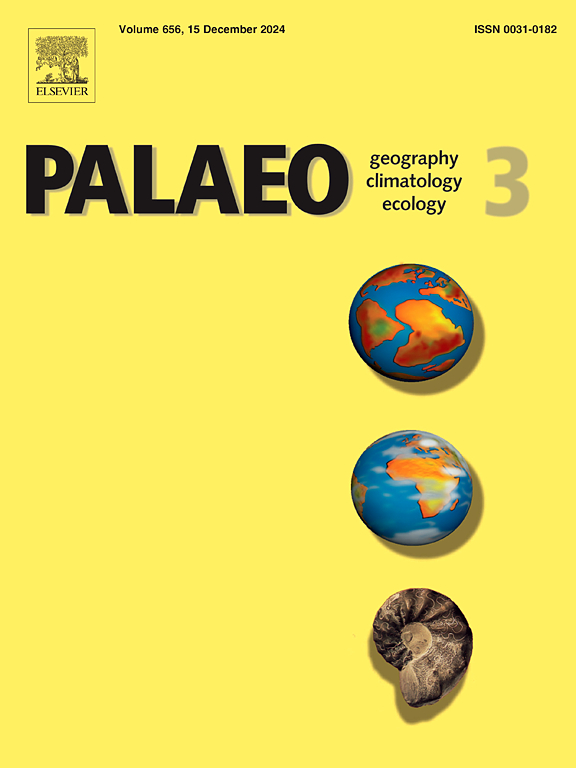Intertropical Convergence Zone modulates Asian dust input to the low-latitude western Pacific during the late Neogene
IF 2.7
2区 地球科学
Q2 GEOGRAPHY, PHYSICAL
Palaeogeography, Palaeoclimatology, Palaeoecology
Pub Date : 2025-05-31
DOI:10.1016/j.palaeo.2025.113074
引用次数: 0
Abstract
Asian dust is one of the primary components of detrital sediment in the tropical western Pacific. Whether low-latitude process influenced the Asian dust input to the low-latitude western Pacific during the late Neogene is still an open question. In this study, we analyzed the grain size composition of the detrital sediments and the radiogenic Sr and Nd isotopes of <4 um components in the International Ocean Discovery Program Site U1490 in the western Pacific warm pool. By using Weibull function fitting, we quantitatively separated fine-grained endmember components (EM2) from the detritus. The results indicate that EM2 primarily originated from dust of the northern Chinese deserts and western and central Chinese deserts, and is transported by the East Asian winter monsoon and westerlies during the late Neogene. The mode grain size of EM2 became significantly coarser at 7.2–4.8 Ma and 3.9–2.6 Ma, most likely due to the enhancement of the atmospheric circulation. The significant increase in EM2 content at 7.2–4.8 Ma and 3.9–2.6 Ma is temporally consistent with the records of Asian aridity and the southward shifts of the Intertropical Convergence Zone (ITCZ). We argue that the deposition of Asian dust in the low-latitude Pacific was influenced not only by the climate (e.g. atmospheric circulation and aridity) of Asian continent, but also was modulated by the paleolocation of the ITCZ. As the major rainfall zone in the low-latitude Pacific, ITCZ influenced the diffusion and deposition of Asian dust. During the late Neogene, the southward shift of the ITCZ forced Asian dust to spread southward and resulted in more Asian dust deposition in the low-latitude western Pacific. Our study demonstrates the important role of low-latitude process on the deposition of Asian dust in the western Pacific during the late Neogene.
热带辐合带对新近纪晚期亚洲低纬度西太平洋沙尘输入的调节作用
亚洲沙尘是热带西太平洋碎屑沉积物的主要成分之一。低纬过程是否影响了新近纪晚期亚洲沙尘对低纬西太平洋的输入,仍然是一个悬而未决的问题。在本研究中,我们分析了西太平洋暖池中国际海洋发现计划站点U1490碎屑沉积物的粒度组成和<; 4um组分的放射性成因Sr和Nd同位素。利用威布尔函数拟合,定量分离了碎屑中细粒端元组分(EM2)。结果表明,EM2主要来源于中国北部沙漠和中西部沙漠的沙尘,并在新近纪晚期由东亚冬季风和西风带输送。在7.2 ~ 4.8 Ma和3.9 ~ 2.6 Ma, EM2模态晶粒尺寸明显变粗,这很可能是由于大气环流增强所致。EM2含量在7.2 ~ 4.8 Ma和3.9 ~ 2.6 Ma的显著增加与亚洲干旱和热带辐合带南移的记录在时间上是一致的。亚洲沙尘在低纬太平洋的沉积不仅受到亚洲大陆气候(如大气环流和干旱)的影响,而且还受到青藏高原古地理位置的调节。ITCZ作为低纬太平洋的主要降雨区,影响着亚洲沙尘的扩散和沉积。新近纪晚期,东太平洋环流南移迫使亚洲沙尘南移,导致低纬西太平洋的亚洲沙尘增多。研究表明,低纬过程在晚新近纪西太平洋亚洲沙尘沉积过程中起着重要作用。
本文章由计算机程序翻译,如有差异,请以英文原文为准。
求助全文
约1分钟内获得全文
求助全文
来源期刊
CiteScore
5.90
自引率
10.00%
发文量
398
审稿时长
3.8 months
期刊介绍:
Palaeogeography, Palaeoclimatology, Palaeoecology is an international medium for the publication of high quality and multidisciplinary, original studies and comprehensive reviews in the field of palaeo-environmental geology. The journal aims at bringing together data with global implications from research in the many different disciplines involved in palaeo-environmental investigations.
By cutting across the boundaries of established sciences, it provides an interdisciplinary forum where issues of general interest can be discussed.

 求助内容:
求助内容: 应助结果提醒方式:
应助结果提醒方式:


